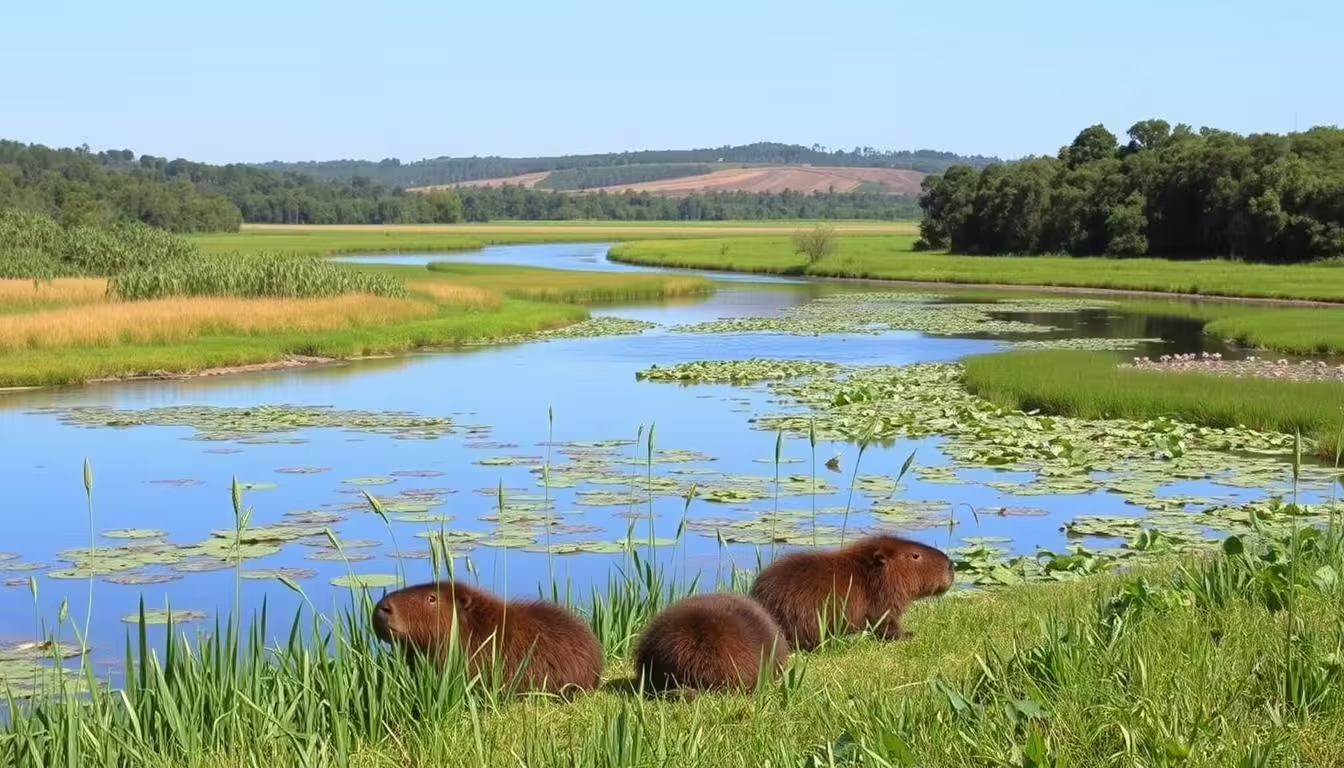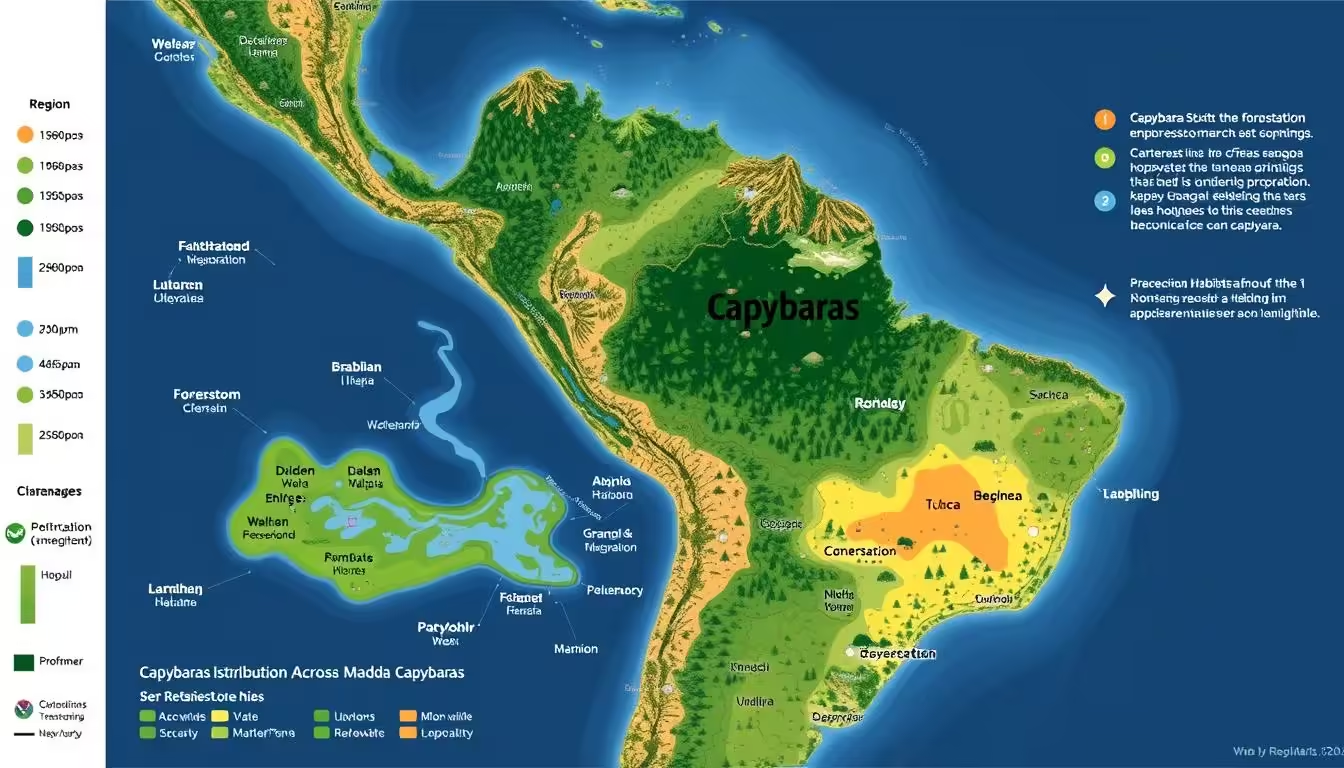Southeastern Brazil has seen big changes in its landscape. These changes are due to more farms and cities. These changes affect where and how many capybaras live.
Scientists use special models to predict where capybaras might live in these new landscapes. The Piracicaba River basin is a key area to study. It shows how human actions affect capybara numbers.
The loss of natural homes and the breaking up of areas have hurt capybara numbers. As their old homes disappear, capybaras must find new places to live. If they can’t, their numbers could drop and they might even disappear from some places.
Key Takeaways
- Deforestation and urbanization in Southeastern Brazil have significantly altered the natural habitats of capybaras.
- Ecological niche modeling can help predict the distribution of capybaras in these modified landscapes.
- The Piracicaba River basin serves as a case study for understanding the impact of human-induced changes on capybara populations.
- Loss of native habitats and habitat fragmentation pose significant threats to the long-term survival of capybaras in the region.
- Capybaras must adapt to the changing landscape or face the risk of declining numbers and potential local extirpation.
The Effects of Deforestation and Urbanization on Capybara Populations
The growth of human settlements and farming has changed Southeastern Brazil’s natural landscapes a lot. This has made life hard for the capybara, a big rodent known for being adaptable and social. They have had to change how they live and where they live because of urban sprawl and ecosystem changes.
With more deforestation and urbanization, capybara habitats are getting broken up. This makes it hard for them to move around and find what they need. Now, capybaras live near people and farms, showing they can adapt to new places.
“Capybaras are known for being one of the friendliest animals, often sharing spaces with other species.”
Even though capybaras can adapt, it’s not clear how these changes will affect them in the long run. Less natural water and plants might make it harder for them to survive. This could change how many capybaras there are and where they live.
Conservation efforts need to find a way to help both humans and wildlife. We must understand how capybaras live in their changed world. By seeing how resilient they are, we can work towards a future where urban sprawl, ecosystem changes, and wildlife adaptation can all exist together.
Transformation of Southeastern Brazilian Landscapes
The landscapes of Southeastern Brazil have changed a lot in recent years. This change affects the region’s ecology a lot. The main reasons are the growth of farms and cities, which have harmed native plants and animals.
Agricultural Expansion Patterns
The growth of farms, especially for sugarcane, has been a big change. Sugarcane has taken over a lot of land, changing the natural habitats. Even if farms use less land, 76,702 hectares of pastures can still be saved. This is 46% of the total pasture area in the Paraitinga Watershed at the Brazilian Atlantic Forest.
Urban Development Trends
The region has also seen a lot of new buildings. Houses and shops have spread into natural areas. This has made it harder for animals, like capybaras, to find homes.
Loss of Native Vegetation
The loss of natural areas is huge. Between 1985 and 2020, the Amazon forest lost 44.53 million hectares. Meanwhile, farms and forests grew by 38.10 and 0.26 million hectares, respectively. This change has affected many animals, including capybaras, making them adapt to new places.
| Ecosystem | Forest Decrease (1985-2020) | Pasture Increase | Agricultural Expansion | Planted Forest Increase |
|---|---|---|---|---|
| Amazon | 44.53 million hectares | 38.10 million hectares | 6.06 million hectares | 0.26 million hectares |
| Atlantic Forest | 0.99 million hectares | 11.53 million hectares | 8.06 million hectares | Unspecified |
Capybara Adaptation to Anthropogenic Environments
The capybara (Hydrochoerus hydrochaeris) has shown an amazing ability to live in human-made landscapes. They can be found in urban parks, farms, and other places changed by humans. This shows their wildlife resilience and skill in adapting to urban ecology.
In Curitiba, Brazil, a city known for its smart planning, capybaras have made themselves at home. They live in parks and rivers, showing they are doing well in the city. Curitiba has a lot of green space, with 64.5 m² for each person, which helps protect the environment. About 20% of the city is forest, with a quarter being public spaces.
But, having more capybaras in cities has caused problems. They can carry diseases like Brazilian Spotted Fever (BSF). This makes it harder to control ticks in cities, which is bad for people’s health.
Curitiba’s fast growth and its wildlife present big challenges. It needs smart planning to keep people and nature in balance. This means finding ways to use resources well, keep people happy, and manage wildlife resilience, urban ecology, and human-wildlife conflict together.
| Metric | Value |
|---|---|
| Curitiba’s population | 1,864,416 inhabitants |
| Curitiba’s green area per inhabitant | 64.5 m² |
| Curitiba’s forested area coverage | 20% of the city’s territory (78 km²) |
| Urbanization rate in Latin America and the Caribbean (2014) | 80% |
| Urbanization rate in Brazil (2014) | 83% |
Population Distribution in Modified Landscapes
Studies show that capybaras like certain areas more than others. They prefer flat places near water bodies because it’s good for them. They also like being near sugarcane fields because there’s lots of food and places to hide.
In cities, capybaras live in parks and green spaces with water. This shows they can live with people around. It’s a sign of their smart ways to adapt and live with humans.
| Habitat Feature | Capybara Preference |
|---|---|
| Flat Areas with Water Bodies | Strong Preference |
| Sugarcane Field Proximity | Frequently Observed |
| Urban Park Settlements | Successful Colonization |
“These distribution patterns highlight the species’ ability to exploit resources in human-modified environments.”
Impact of Agricultural Intensification on Capybara Habitats
Agricultural intensification, especially sugarcane monocultures, has hurt capybara habitats in Southeastern Brazil. Capybaras have learned to live in these areas, but the loss of native plants is bad for the ecosystem.
The change from natural habitats to farmland has affected capybaras’ food, shelter, and places to breed. The growth of monoculture expansion has caused biodiversity loss and messed up the ecosystem services capybaras need.
Capybaras are good at adapting, but their future in these changed places is uncertain. As farming gets more intense, finding a balance between capybara needs and human activities is key.
| Metric | Value |
|---|---|
| Percentage of zoonotic disease events caused by wildlife-origin pathogens (1940-2004) | Over 70% |
| Zoonotic disease outbreaks globally (1980-2013) | 12,012 |
| Emerging and re-emerging zoonoses (recent decades) | Over 50% |
| Ebola outbreaks in the Democratic Republic of Congo (since 1970s) | 11, with 6 occurring in the past decade |
As the need for food and products grows, finding a balance is vital. We need sustainable farming, restoring habitats, and making decisions that protect capybaras and their homes in Southeastern Brazil.
Urban Sprawl and Capybara Territory Fragmentation
Urban areas are growing fast, and capybaras are feeling the squeeze. These large rodents face big challenges as their homes get broken up. They can’t easily find food or move between groups, which is key for their survival.
Habitat Connectivity Issues
In Southeastern Brazil, cities are spreading out and cutting up capybara habitats. What was once a big area is now many small pieces. This makes it hard for capybaras to roam and find what they need.
This problem is bad for their genes. Capybaras need to mix with others to stay healthy. But now, they can’t do that as much.
Population Isolation Effects
When capybaras are stuck in small areas, they’re in big trouble. They’re more likely to disappear because of diseases or bad weather. They also lose the ability to adapt to changes.
We need to figure out how to save capybaras from cities. We must keep their homes connected and help them survive. This means working together on city planning, wildlife care, and fixing the environment.
Conservation Challenges in Human-Modified Landscapes
Protecting capybara populations in areas changed by humans is tough. It’s a mix of wildlife management, urban planning, and ecosystem restoration. We need new ways to manage land. We must solve problems like habitat breaks, human-wildlife fights, and keeping nature connected.
In Brazil’s Atlantic Forest, capybaras live in a place where forests now cover just 12% of their former area. The Cerrado region has lost about half of its natural plants to farming and grazing. These big losses of deforestation and habitat loss hurt capybaras a lot.
| Landscape Transformation | Impacts on Capybaras |
|---|---|
| Agricultural expansion | Fragmentation of habitats, loss of natural water bodies and food sources |
| Urban development | Increased human-wildlife conflicts, reduced connectivity between populations |
| Sugarcane cultivation | Proximity to water bodies and food sources, but potential for pesticide exposure |
We must find ways for capybaras and humans to live together. This could mean making green spaces in cities, keeping habitats connected, and farming in ways that don’t harm capybaras.
By tackling the big problems of human-modified landscapes, we can help capybaras survive. This is key to their future in a world facing many environmental pressures.
Ecological Niche Modeling for Capybara Population Management
Urban areas and farms are growing fast. This makes it key to know what capybaras need to survive. Predictive modeling and species distribution modeling are now big helps in finding and managing their homes.
In Brazil’s Piracicaba River basin, studies show how good these models are. They can spot where capybaras live with just a small mistake. But, they struggle more with predicting where they might be in changed landscapes.
Even with these hurdles, species distribution models offer great help. They show where capybaras might live, helping to save their homes. This knowledge helps in planning how to use the land in ways that protect these animals.
South America’s landscapes are changing fast. We need new ways to manage capybara numbers. With predictive modeling, experts and land managers can help capybaras thrive. This way, capybaras and people can live together well.
Future Prospects for Capybara-Human Coexistence
The United States is changing fast with more farms and cities. The future of capybaras depends on blending wildlife care into land use plans. It’s key to manage urban wildlife well and keep wildlife corridors open.
Using adaptive management is vital. This means always checking and learning to improve conservation. Teaching local people about urban wildlife can also help. It can make them understand and respect capybaras more.
We can keep capybaras safe by saving their homes, farming better, and linking up broken areas. But, we face big challenges like losing habitats and diseases. We need a plan that connects human, animal, and environmental health.



